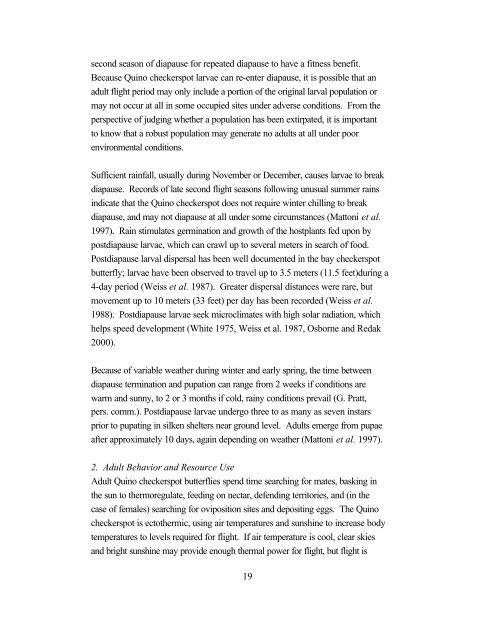Outline of Quino Recovery Plan - The Xerces Society
Outline of Quino Recovery Plan - The Xerces Society
Outline of Quino Recovery Plan - The Xerces Society
Create successful ePaper yourself
Turn your PDF publications into a flip-book with our unique Google optimized e-Paper software.
second season <strong>of</strong> diapause for repeated diapause to have a fitness benefit.<br />
Because <strong>Quino</strong> checkerspot larvae can re-enter diapause, it is possible that an<br />
adult flight period may only include a portion <strong>of</strong> the original larval population or<br />
may not occur at all in some occupied sites under adverse conditions. From the<br />
perspective <strong>of</strong> judging whether a population has been extirpated, it is important<br />
to know that a robust population may generate no adults at all under poor<br />
environmental conditions.<br />
Sufficient rainfall, usually during November or December, causes larvae to break<br />
diapause. Records <strong>of</strong> late second flight seasons following unusual summer rains<br />
indicate that the <strong>Quino</strong> checkerspot does not require winter chilling to break<br />
diapause, and may not diapause at all under some circumstances (Mattoni et al.<br />
1997). Rain stimulates germination and growth <strong>of</strong> the hostplants fed upon by<br />
postdiapause larvae, which can crawl up to several meters in search <strong>of</strong> food.<br />
Postdiapause larval dispersal has been well documented in the bay checkerspot<br />
butterfly; larvae have been observed to travel up to 3.5 meters (11.5 feet)during a<br />
4-day period (Weiss et al. 1987). Greater dispersal distances were rare, but<br />
movement up to 10 meters (33 feet) per day has been recorded (Weiss et al.<br />
1988). Postdiapause larvae seek microclimates with high solar radiation, which<br />
helps speed development (White 1975, Weiss et al. 1987, Osborne and Redak<br />
2000).<br />
Because <strong>of</strong> variable weather during winter and early spring, the time between<br />
diapause termination and pupation can range from 2 weeks if conditions are<br />
warm and sunny, to 2 or 3 months if cold, rainy conditions prevail (G. Pratt,<br />
pers. comm.). Postdiapause larvae undergo three to as many as seven instars<br />
prior to pupating in silken shelters near ground level. Adults emerge from pupae<br />
after approximately 10 days, again depending on weather (Mattoni et al. 1997).<br />
2. Adult Behavior and Resource Use<br />
Adult <strong>Quino</strong> checkerspot butterflies spend time searching for mates, basking in<br />
the sun to thermoregulate, feeding on nectar, defending territories, and (in the<br />
case <strong>of</strong> females) searching for oviposition sites and depositing eggs. <strong>The</strong> <strong>Quino</strong><br />
checkerspot is ectothermic, using air temperatures and sunshine to increase body<br />
temperatures to levels required for flight. If air temperature is cool, clear skies<br />
and bright sunshine may provide enough thermal power for flight, but flight is<br />
19
















